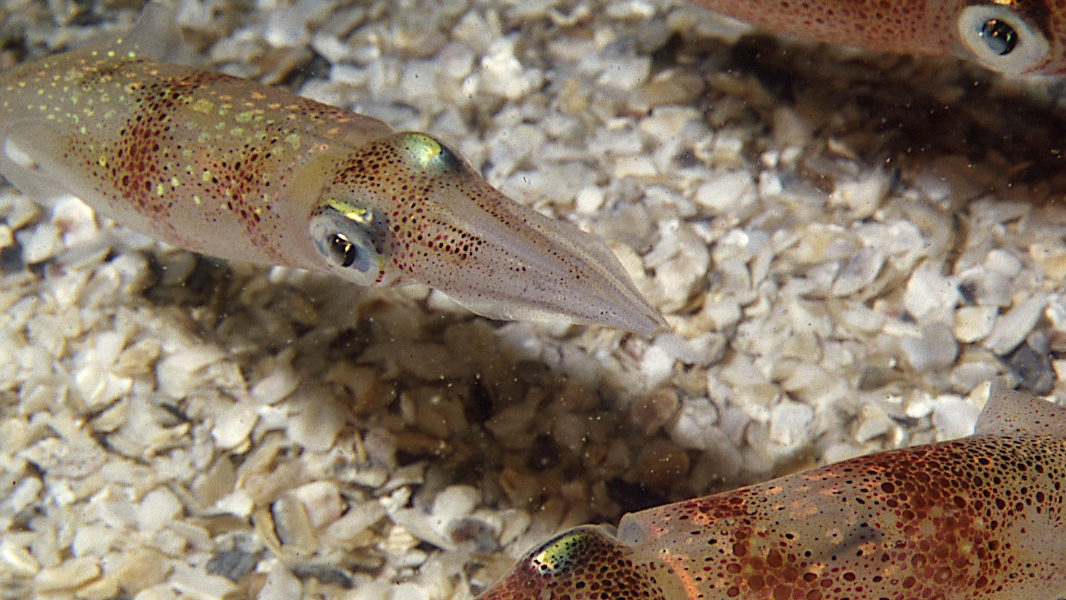New Cell Structures Discovered in Squid Skin Lead to Bioengineering of Tunable, Multispectral Materials

An exciting study in Science this week extends what we thought we knew about structural color in nature — from the constant, brilliant blue of Morpho butterfly wings to the ultrafast, dynamic camouflaging of cephalopod skin.
By examining squid skin cells three-dimensionally, researchers from University of California-Irvine and the Marine Biological Laboratory (MBL) have unveiled the nanostructures that allow these animals to dynamically change their appearance from transparent to a dazzling array of colored states.
This fundamental discovery has also inspired the bio-engineering of new, tunable, multispectral materials.
“We discovered new cell types in the iridescent splotches that are distributed all over squid skin,” said co-author Roger Hanlon, senior scientist at the Marine Biological Laboratory (MBL). These splotches contain reflective cells called iridophores, which “can be transparent or change to vibrant colors throughout the color range (i.e., the rainbow) and back to invisible,” Hanlon said.

Using cutting-edge microscopic holotomography at UC Irvine, the researchers imaged an intricate, 3D organization of reflective protein structures within these newly observed types of iridophores.
“This technology allowed us to measure the refractive index in these new cell types in 3D,” Hanlon said. “Surprise discovery: there is an unusual continuous refractive index profile in each cell.” This gradient of refractive indices allows the squid skin splotches to reversibly transition between transparent and colored states.
Inspired by this cellular dexterity, the scientists and engineers have developed sophisticated new cloth-like materials that have tunable, multispectral visibility and color — with promising applications for camouflage, thermal management, sensors, and displays.
“These bioinspired materials go beyond simple static color control, as they can dynamically adjust both their appearances in the visible and infrared in response to environmental or mechanical stimuli,” said co-first author Aleksandra Strzelecka, Ph.D. candidate in chemical and biomolecular engineering at UC-Irvine.
The senior author on the study is Alon Gorodetsky, professor of chemical and biomolecular engineering at UC Irvine. Read the UC Irvine press release on this paper here.
The Roger Hanlon lab, including co-author Stephen Senft, has been a leader in unraveling the biology of dynamic structural coloration in squid and other cephalopods over several decades.
The research was funded by the Defense Advanced Research Projects Agency and the Air Force Office of Scientific Research.
Citation:
Georgii Bogdanov, Aleksandra Anna Strzelecka, Nikhil Kaimal, Stephen L. Senft, Sanghoon Lee, Roger T. Hanlon and Alon A. Gorodetsky (2025) Gradient refractive indices enable squid structural color and inspire multispectral materials. Science, DOI: 10.1126/science.adn1570.
Selected Media Coverage:
Squid use Bragg reflectors in their skin to change colour | Physics World
Squid-Inspired Stretchable Camo | Interesting Engineering
—###—
The Marine Biological Laboratory (MBL) is dedicated to scientific discovery – exploring fundamental biology, understanding marine biodiversity and the environment, and informing the human condition through research and education. Founded in Woods Hole, Massachusetts in 1888, the MBL is a private, nonprofit institution and an affiliate of the University of Chicago.